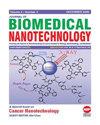Coptisine Down-Regulates Soluble Intercellular Adhesion Molecule-1 by Inactivating Fas/FasL Signaling Pathway to Inhibit the Recurrence After Orthodontics
IF 2.9
4区 医学
Q1 Medicine
引用次数: 0
Abstract
In this study, by constructing a rat model of orthodontic recurrence and intervening with coptisine, the IL-6, IL-8, TNF-α and soluble intercellular adhesion molecule-1 (sICAM-1) content were analyzed to assess the regulatory mechanism of coptisine on the health status of recurrent periodontal tissue after orthodontics and the occurrence of periodontal tissue inflammation. Male rats were assigned into three groups by constructing coptisine liposome nano-objects: blank group (Blank, 10 rats), orthodontic tooth movement model group (50 rats). The orthodontic tooth movement model group was randomly divided into model group (module), model control group (control-free), model coptisine treatment group (treatment-free), model blank functional liposome group (control-lip) and model functional coptisine liposome group (treatment-lip). Rats in model group were killed on the day after device was removed. Rats in other groups received equal doses of normal saline, coptisine, blank functional liposomes, and functional coptisine liposomes by intragastric administration on the day of device removal and then were killed after 7 days of continuous treatment. Through Kyoto Encyclopedia of Genes and Genomes (KEGG) enrichment analysis, we found that Fas/FasL signaling pathway was enriched in pathways related to apoptosis, disease infection and inflammation. Western blot experiments confirmed that coptisine could inhibit Fas/FasL signaling activation in the process of relapse after orthodontics. Lipopolysaccharides (LPS) treatment significantly increased inflammatory cytokines and sICAM-1, as well as the level of Fas and FasL. Coptisine treatment inhibited LPS-induced Fas/FasL signaling pathway in periodontal ligament cells. Coptisine attenuated the relapsed inflammation after orthodontics by inhibiting Fas/FasL signaling.柯普替辛通过抑制 Fas/FasL 信号通路来下调可溶性细胞间粘附分子-1,从而抑制牙齿矫正后的复发
本研究通过构建正畸复发大鼠模型并干预黄柏碱,分析其IL-6、IL-8、TNF-α及可溶性细胞间粘附分子-1 (sICAM-1)含量,探讨黄柏碱对正畸术后复发牙周组织健康状况及牙周组织炎症发生的调节机制。通过构建coptisine脂质体纳米物,将雄性大鼠分为空白组(blank, 10只大鼠)、正畸牙齿运动模型组(50只大鼠)。正畸牙运动模型组随机分为模型组(模组)、模型对照组(无对照组)、模型黄柏碱治疗组(无治疗组)、模型空白功能脂质体组(对照-唇组)和模型功能黄柏碱脂质体组(治疗-唇组)。模型组大鼠于取下装置次日处死。其余各组大鼠在取下装置当天分别灌胃等量生理盐水、黄柏碱、空白功能脂质体、黄柏碱功能脂质体,连续给药7 d后处死。通过京都基因与基因组百科全书(KEGG)富集分析,我们发现Fas/FasL信号通路在细胞凋亡、疾病感染和炎症相关通路中富集。Western blot实验证实,coptisine可以抑制正畸术后复发过程中Fas/FasL信号的激活。脂多糖(LPS)处理显著增加炎性细胞因子和sICAM-1,以及Fas和FasL水平。黄柏碱抑制lps诱导的牙周膜细胞Fas/FasL信号通路。黄柏碱通过抑制Fas/FasL信号通路减轻正畸术后复发性炎症。
本文章由计算机程序翻译,如有差异,请以英文原文为准。
求助全文
约1分钟内获得全文
求助全文
来源期刊
CiteScore
4.30
自引率
17.20%
发文量
145
审稿时长
2.3 months
期刊介绍:
Information not localized

 求助内容:
求助内容: 应助结果提醒方式:
应助结果提醒方式:


